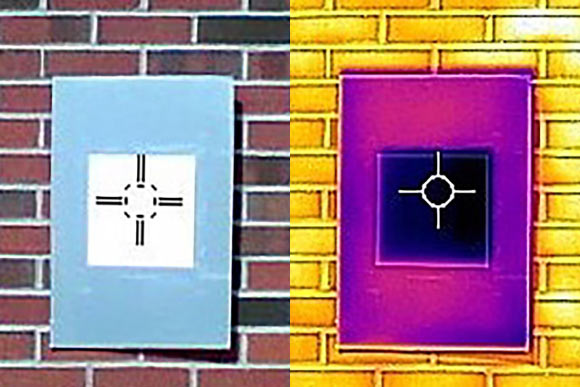The new barium sulfate- (BaSO4) acrylic paint has a solar reflectance of 98.1%, according to a paper published online in the journal ACS Applied Materials & Interfaces.

An infrared camera shows how a sample of the whitest white paint (the dark purple square in the middle) actually cools the board below ambient temperature, something that not even commercial ‘heat rejecting’ paints do. Image credit: Joseph Peoples / Purdue University.
Two features give the newly-developed white paint its extreme whiteness.
One is the high concentration of barium sulfate, which is also used to make photo paper and cosmetics white.
The second feature is that the barium sulfate particles are all different sizes in the paint.
How much each particle scatters light depends on its size, so a wider range of particle sizes allows the paint to scatter more of the light spectrum from the Sun.
“We looked at various commercial products, basically anything that’s white,” said Dr. Xiangyu Li, a postdoctoral researcher at MIT.
“We found that using barium sulfate, you can theoretically make things really, really reflective, which means that they’re really, really white.”
“A high concentration of particles that are also different sizes gives the paint the broadest spectral scattering, which contributes to the highest reflectance,” added Joseph Peoples, a Ph.D. student in the School of Mechanical Engineering at Purdue University.
The new paint formulation reflects up to 98.1% of sunlight and sends infrared heat away from a surface at the same time.
The paint’s whiteness also means that the paint is the coolest on record.
“If you were to use this paint to cover a roof area of about 1,000 square feet, we estimate that you could get a cooling power of 10 kilowatts,” said Professor Xiulin Ruan, a researcher in the School of Mechanical Engineering and the Birck Nanotechnology Center at Purdue University.
“That’s more powerful than the central air conditioners used by most houses.”
_____
Xiangyu Li et al. Ultrawhite BaSO4 Paints and Films for Remarkable Daytime Subambient Radiative Cooling. ACS Appl. Mater. Interfaces, published online April 15, 2021; doi: 10.1021/acsami.1c02368






